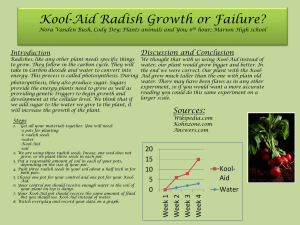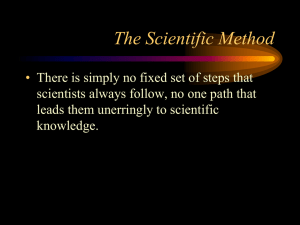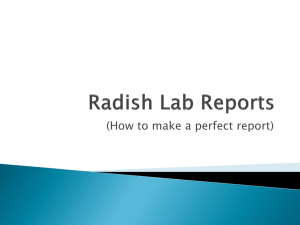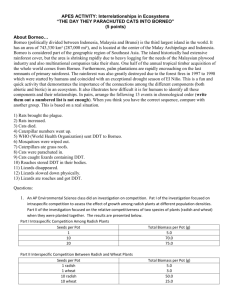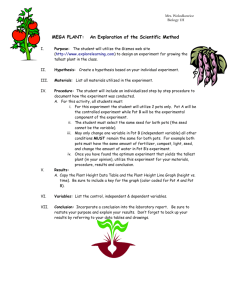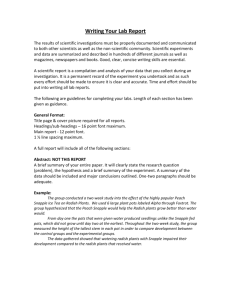Plant Competition
advertisement
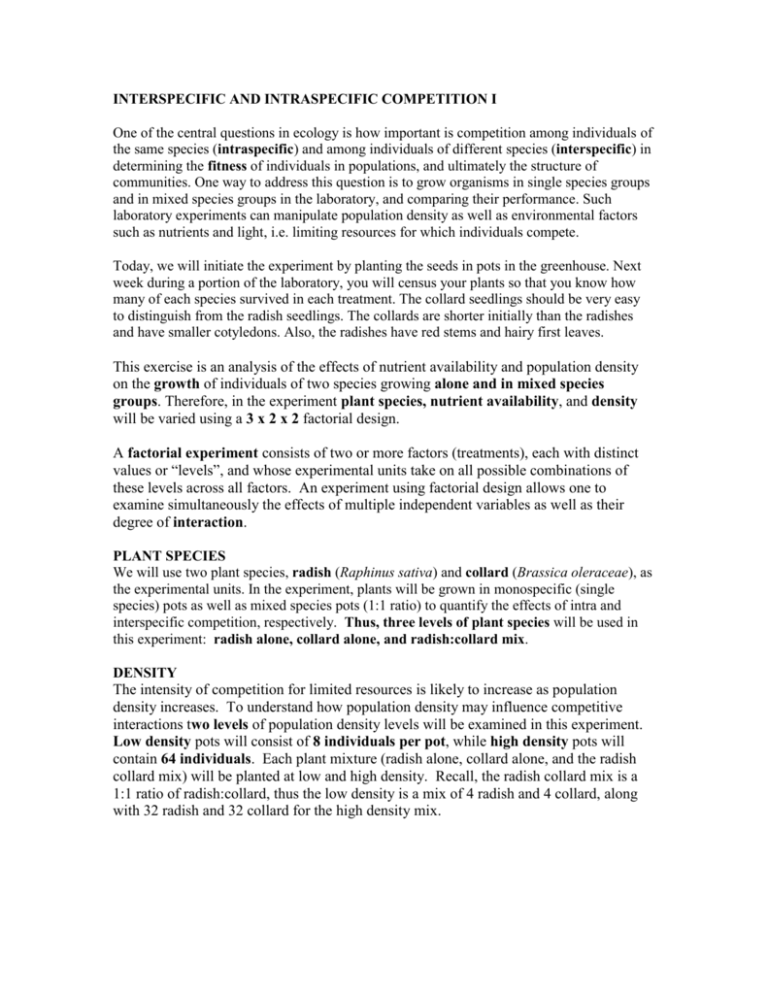
INTERSPECIFIC AND INTRASPECIFIC COMPETITION I One of the central questions in ecology is how important is competition among individuals of the same species (intraspecific) and among individuals of different species (interspecific) in determining the fitness of individuals in populations, and ultimately the structure of communities. One way to address this question is to grow organisms in single species groups and in mixed species groups in the laboratory, and comparing their performance. Such laboratory experiments can manipulate population density as well as environmental factors such as nutrients and light, i.e. limiting resources for which individuals compete. Today, we will initiate the experiment by planting the seeds in pots in the greenhouse. Next week during a portion of the laboratory, you will census your plants so that you know how many of each species survived in each treatment. The collard seedlings should be very easy to distinguish from the radish seedlings. The collards are shorter initially than the radishes and have smaller cotyledons. Also, the radishes have red stems and hairy first leaves. This exercise is an analysis of the effects of nutrient availability and population density on the growth of individuals of two species growing alone and in mixed species groups. Therefore, in the experiment plant species, nutrient availability, and density will be varied using a 3 x 2 x 2 factorial design. A factorial experiment consists of two or more factors (treatments), each with distinct values or “levels”, and whose experimental units take on all possible combinations of these levels across all factors. An experiment using factorial design allows one to examine simultaneously the effects of multiple independent variables as well as their degree of interaction. PLANT SPECIES We will use two plant species, radish (Raphinus sativa) and collard (Brassica oleraceae), as the experimental units. In the experiment, plants will be grown in monospecific (single species) pots as well as mixed species pots (1:1 ratio) to quantify the effects of intra and interspecific competition, respectively. Thus, three levels of plant species will be used in this experiment: radish alone, collard alone, and radish:collard mix. DENSITY The intensity of competition for limited resources is likely to increase as population density increases. To understand how population density may influence competitive interactions two levels of population density levels will be examined in this experiment. Low density pots will consist of 8 individuals per pot, while high density pots will contain 64 individuals. Each plant mixture (radish alone, collard alone, and the radish collard mix) will be planted at low and high density. Recall, the radish collard mix is a 1:1 ratio of radish:collard, thus the low density is a mix of 4 radish and 4 collard, along with 32 radish and 32 collard for the high density mix. NUTRIENTS Competition between individuals may occur for one or more limiting resources including space, nutrients, mates, etc. For plants living in the same location, competition is often intense for vital nutrients (e.g. nitrogen and phosphorous) which must be obtained from the soil. In areas of high nutrient availability you might predict that plants would grow faster, and that competition for light (maximizing photosynthesis and growth) may be more important. On the other hand, in areas of poor nutrient availability, plants may grow more slowly, and competition may shift belowground to increase root growth, and maximize growth via nutrient acquisition. These predictions may or may not be valid for your experiment. The outcome of competition under high and low nutrient availability may seem straightforward, but the results may depend on the interaction between nutrient and density treatments. For example one of the species may perform better at low density but be severely impaired at high density. It is up to you to investigate the background literature, and decide for yourself based on available data what you predict will be the outcome of competition under these experimental conditions. Two levels of nutrients will be established in this experiment (low and high). The high nutrient treatment will include the addition of slow-release fertilizer to two replicates of each species x density treatment (see experimental design below). The low nutrient treatment will consist of unmanipulated soil. Both low and high nutrient availability levels will be established at all levels of density and plant species. Be sure to follow the labeling scheme (Table 1) in order to keep track of each individual species x density x nutrient treatment. Important note: The success of this experiment depends on the ability of the investigator to implement the design in a consistent manner. If you place all of the seeds in the center of the pot, the actual density that the seedling will experience will be much greater than what the experimental design intended. Place the seeds equidistant from one another. In pots where two species are present, alternate species in your planting array. This will cause each individual of the two species to encounter individuals of the other species to the same extent. After arranging your seeds on the surface of the soil in the pot, cover them with a thin layer (1 cm) of soil by sprinkling soil across the top. Be careful not to bury them too deeply. Be sure to label each of your pots with a tape label (see labeling scheme in Table 1). Each week you will census your plants and observe their growth e.g. how many of each species in each pot have their first true leaves, second true leaves, etc. After five weeks we will terminate the experiment and collect the above ground portions of the plants. These will be counted and weighed to determine which species was most successful under which treatment. The observations that you make each week are very important. The first week's observations tell you how successful you were at setting up the experiment, how many seeds germinated successfully and in what spatial array. The subsequent weeks’ observations reveal the course of the competitive interactions: are all plants growing at the same rate in all treatments, how are the plants different, etc. These observations are what will allow you to interpret fully the final biomass results of your experiment. EXPERIMENTAL DESIGN In this experiment you are manipulating three variables, each with discrete levels. There are 3 levels of plant species (radish alone, collard alone, and radish:collard mix), 2 levels of density (low and high) and 2 levels of nutrients (low and high) for a 3 x 2 x 2 design. Therefore, there are 12 possible treatment combinations. The class will be broken down into 4 groups of students. Each group is responsible for planting TWO REPLICATES of each of the 12 possible treatment combinations. THUS, EACH GROUP IS WILL PLANT 24 TOTAL POTS. The replicates from all groups will be pooled at the termination of the experiment. Table 1: Experimental design and treatment combinations for plant competition. PLANT SPECIES Density 8 64 nutrients low low high high low low high high Replicate 1 2 1 2 1 2 1 2 RADISH ALONE Pot label 1R-8-L 2R-8-L 1R-8-H 2R-8-H 1R-64-L 2R-64-L 1R-64-H 2R-64-H COLLARD ALONE Pot label 1C-8-L 2C-8-L 1C-8-H 2C-8-H 1C-64-L 2C-64-L 1C-64-H 2C-64-H RADISH:COLLARD MIX Pot label 1R:C-8-L 2R:C-8-L 1R:C-8-H 2R:C-8-H 1R:C-64-L 2R:C-64-L 1R:C-64-H 2R:C-64-H Pot label code = replicate# plant species - density - nutrient treatment Be sure to label all of your pots as indicated in Table 1, and with your group name and section number. PLANT COMPETITION LABORATORY SET UP NOTES There are a few important details about the lab set-up that must be kept in mind in order to execute a precise and rigorous experiment. 1. For all treatments be sure to space the seeds in a uniform distribution in the pots. That is, be sure to space the seeds equidistantly from one another. DO NOT PLACE SEEDS IN A CLUMP IN THE MIDDLE OF THE POT! 2. For the mixed species treatments: Be sure to alternate seed patterns (radish, collard, radish, collard). YOU DO NOT WANT ALL THE RADISH SEEDS ON ONE SIDE, AND ALL THE COLLARD SEEDS ON THE OTHER SIDE. 3. For all treatments: be sure to cover the seeds with approximately the same amount of soil. The seeds in all replicates should sit approximately 1 cm below the soil surface. THIS IS IMPORTANT, AS YOU WANT ALL THE SEEDS TO GERMINATE AT THE SAME TIME. 4. Be sure to label your pots with pot label code (see above), group name, and section number.
